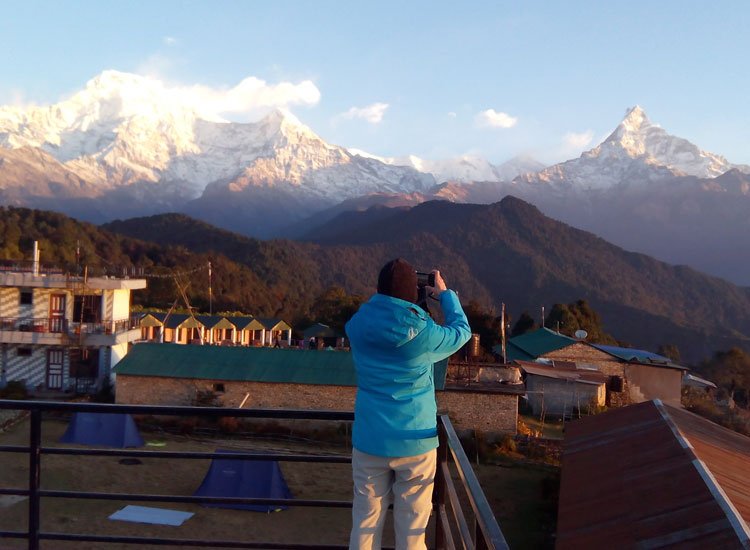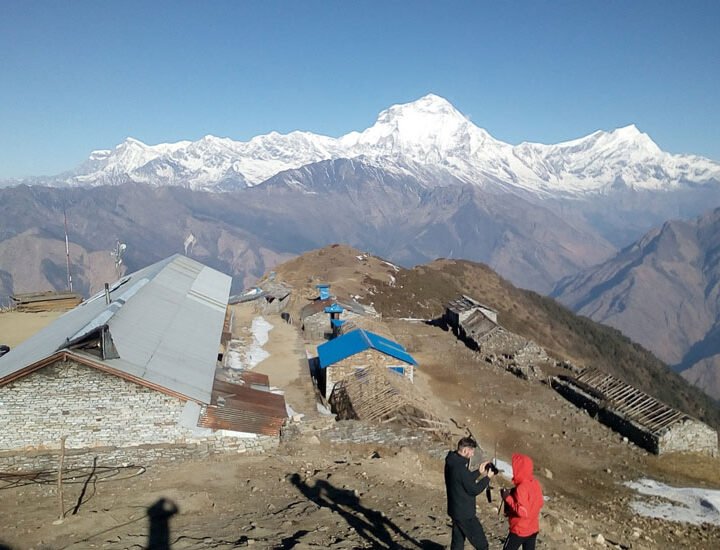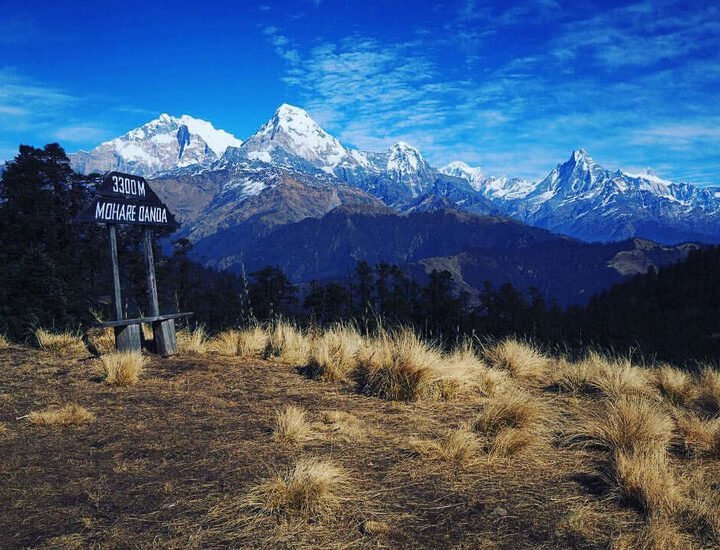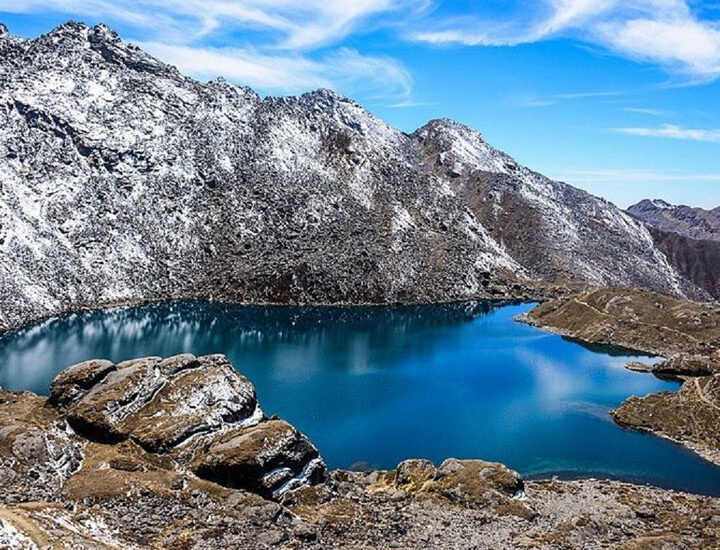- Details
Detailed itinerary
Itinerary- Tour Includes/Excludes
- Useful Info
- FAQ
Trip overview
Trekking is not limited to any age group as long as an individual is fit and healthy. Many treks in Nepal can be done by children as well as elderly people. Any long trek in the Himalayas can feel tiring. After its completion, you’ll be both mentally and physically exhausted. At this time, our Himalayas View Trek with Hot Springs comes for your rescue.
This trek is designed forenthusiastic trekkers wanting proper relaxation after the end of the trek. The trek takes you to the famous hot springs of the Annapurna region. This trek is also specially designed for the suitability of elderly trekkers.So, the trails are safe with fewer obstacles like rocky paths and can be quickly done.
This trek is a comparatively easy one in the foothills of the Himalayas. The first resting point of the trek is at Ghandruk, where the Gurung community will amaze you with their rich culture and lifestyle. The next stop will be at Jhinu Danda, where the famous natural springs exist. Taking a bath here relieves you from all the pain from the trek. Elderly people can also relax in the natural springs.
The next stop is Landruk, another rustic village of the region. From Landruk, you trek to Dhampus, which offers some of the most enchanting sunset and sunrise views in the region. The Dhampus view tower has one of the best views of the Annapurna massif and the neighboring mountains. After enjoying the spectacular views, the trek comes to an end with your return to Kathmandu via Pokhara.
Golden Himalayan Zone is the best when it comes to trekking. We provide the most excellent services of transportation, accommodation, and other miscellaneous services to make your trip unforgettable. Along with it, the best guides and staff will accompany you.
Trip highlights
- Enjoy an easy trek, specially designed for the elderly
- Admire spectacular views of the sunset and sunrise above the Annapurna range
- Get to know about the lifestyle of the local Gurung and Magar people
- Relax as you dip in the famous natural springs
Itinerary
The trip starts with you to arrive in the capital city, Kathmandu. As per your scheduled flight, you land at Tribhuvan International Airport. Our staff will be waiting to welcome you warmly, and after brief introductions, you head to the hotel. After refreshing, you join our teams again to welcome dinner and discuss the details of the trek.
Today, you head to Pokhara, from where the trek starts. You can either choose to drive or fly there. The drive takes 6-7 hours along Prithivi Highway, and you get to enjoy beautiful views of the Trishuli River and hill landscape. Meanwhile, the flight is the shorter mode of transportation as it takes 25 minutes to reach Pokhara. The scenic flight takes above the city of lakes with panoramic views of the mountains.
After breakfast, you board the vehicle that’ll take you to Kimche. The 2hr drive will take you through beautiful sceneries of Pokhara Valley. Once you reach Kimche, you rest and prepare to trek. You ascend to Ghandruk village, which is mostly inhabited by the Gurung community. After the short ascent, you arrive at the village for overnight stay.
After enjoying the welcoming culture of the Gurungs, you trek through the rhododendron forests and then trek along the Modi River. After passing some settlement areas, you arrive at Jhinu danda, which is famous for the natural hot springs. After checking in at the lodge, you head to the hot springs and wash away your fatigue.
After the relaxing time at the hot springs, you head to another destination, Landruk. You go downhill till you reach a stream, and from there, you ascend to Landruk. After passing several villages, you arrive at Landruk for overnight stay.
After breakfast, you continue the trek through farmlands. En route, you get to see amazing views of Annapurna, Machhapuchhre, and Dhaulagiri. Then, you arrive Tolka and trek through the forest to reach Deurali. From there, you descend to Dhampus for overnight stay.
You wake up at dawn to see the sunrise over the tall mountains. The spectacular view of sunrays over mountains like Annapurna, Nilgiri, Dhaulagiri, and Machhapuchhre is a view that will remain with you forever. After soaking in the panoramic views, you have your breakfast and then drive to Pokhara.
The trek gradually comes to an end as you return to Kathmandu. You can either choose to drive or fly back. If you have free time before dinner, you can go for souvenir shopping. Then, you join our staff for a farewell dinner.
Today is the last day of the trip. Please make sure you have all your belongings with you. Our staff will make sure to drop you off at the airport on time for your flight. Thank you for making memories with us, and we hope to see you soon!
Included
- Pick-up and drop-off from the airport
- Accommodation during the trek (usually basic teahouses or lodges)
- Meals during the trek (breakfast, lunch, and dinner)
- Experienced trekking guide and porter(s)
- Necessary permits and entry fees
- Transportation to and from the trailhead
- Hot spring experience
Excluded
- International airfare
- Travel insurance
- Personal expenses, such as extra snacks, drinks, or souvenirs
- Tips for the guide and porter(s)
- Accommodation and meals in Kathmandu or Pokhara (if applicable)
- Any additional activities or excursions not included in the package
Useful Info
- Trekking routes: There are several trekking routes in Nepal that offer Himalayan views and hot spring experiences. Some popular routes include Poon Hill trek with hot spring, Langtang valley trek with hot spring, and Annapurna Base Camp trek with hot spring.
- Trekking difficulty: Trekking in the Himalayas can be challenging, especially if you are not used to high altitudes or steep terrain. It's important to choose a trek that suits your fitness level and experience. Most Himalayas view treks with hot spring experiences are graded as moderate to strenuous, and require a good level of fitness and endurance.
- Altitude sickness: Altitude sickness is a common problem for trekkers in the Himalayas, especially if you are trekking at high altitudes. Symptoms can include headache, nausea, and fatigue. It's important to acclimatize properly and to take your time when trekking at high altitudes. You should also be prepared to seek medical attention if necessary.
- Weather: The weather in the Himalayas can be unpredictable, and it's important to be prepared for a range of conditions. The best time to do a Himalayas view trek with hot spring experience is generally in the spring (March to May) or autumn (September to November), when the weather is dry and stable. However, you should also be prepared for rain, snow, and cold temperatures, especially at higher altitudes.
- Hot spring experience: The hot springs in the Himalayas are a great way to relax and rejuvenate after a long day of trekking. However, it's important to be respectful of local customs and to follow basic hygiene practices, such as showering before entering the hot springs and not using soap or shampoo in the water. You should also bring your own towel and bathing suit.
- Accommodation: Accommodation during a Himalayas view trek with hot spring experience is usually basic teahouses or lodges, with shared rooms and communal bathrooms. It's important to be prepared for simple facilities and to bring your own sleeping bag and other essential gear.
FAQs
-
Is it safe to do a Himalayas view trek with hot spring experience?
Yes, with proper planning and preparation, a Himalayas view trek with hot spring experience can be a safe and enjoyable adventure. It's important to choose a reputable trekking operator, to acclimatize properly, and to follow basic safety guidelines while trekking.
-
How long does a Himalayas view trek with hot spring experience usually take?
The duration of a Himalayas view trek with hot spring experience can vary depending on the trekking route and the level of comfort and luxury. Generally, a trek can take anywhere from 5 to 14 days or more.
-
What level of fitness is required for a Himalayas view trek with hot spring experience?
Most Himalayas view treks with hot spring experiences are graded as moderate to strenuous, and require a good level of fitness and endurance. It's important to train and prepare for the trek in advance, and to consult with your doctor if you have any pre-existing health conditions.
-
What kind of gear do I need for a Himalayas view trek with hot spring experience?
You will need a range of gear for a Himalayas view trek with hot spring experience, including hiking boots, warm and waterproof clothing, a sleeping bag, a daypack, and other essential items. You can rent or buy gear in Kathmandu or Pokhara, or bring your own from home.
-
What should I expect from the hot spring experience?
The hot springs in the Himalayas are a great way to relax and rejuvenate after a long day of trekking. The water is usually around 40°C and is believed to have healing properties. However, you should be respectful of local customs and follow basic hygiene practices when using the hot springs.
-
Can I do a Himalayas view trek with hot spring experience alone, or do I need a guide?
It's possible to do a Himalayas view trek with hot spring experience alone, but it's generally recommended to go with a guide and porter(s) for safety and convenience. A guide can also provide valuable information about the local culture, history, and geography, and can help you to navigate the trekking route.






